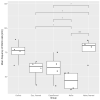Relaying Aversive Ultrasonic Alarm Calls Depends on Previous Experience. Empathy, Social Buffering, or Panic?
- PMID: 34201037
- PMCID: PMC8227955
- DOI: 10.3390/brainsci11060759
Relaying Aversive Ultrasonic Alarm Calls Depends on Previous Experience. Empathy, Social Buffering, or Panic?
Abstract
Ultrasonic vocalizations are among the oldest evolutionarily forms of animal communication. In order to study the communication patterns in an aversive social situation, we used a behavioral model in which one animal, the observer, is witnessing as his cagemate, the demonstrator, is experiencing a series of mild electrical foot shocks. We studied the effect of the foot shock experience on the observer and the influence of a warning sound (emitted shortly before the shock) on USV communication. These experiments revealed that such a warning seems to increase the arousal level, which differentiates the responses depending on previous experience. This can be identified by the emission of characteristic, short 22 kHz calls of a duration below 100 ms. Two rats emitted calls that overlapped in time. Analysis of these overlaps revealed that in 'warned' pairs with a naive observer, 22 kHz calls were mixed with 50 kHz calls. This fact, combined with a high fraction of very high-pitched 50 kHz calls (over 75 kHz), suggests the presence of the phenomenon of social buffering. Pure 22 kHz overlaps were mostly found in 'warned' pairs with an experienced observer, suggesting a possible fear contagion with distress sharing. The results show the importance of dividing 22 kHz calls into long and short categories.
Keywords: 22 kHz calls; 50 kHz calls; aversive state; communication; distress; emotional contagion; fear contagion; social buffering; ultrasonic vocalization.
Conflict of interest statement
The authors declare no conflict of interest. National Science Centre, Poland had no role in study design; in the design of the study; in the collection, analyses, or interpretation of data; in the writing of the manuscript; or in the decision to publish the results.
Figures









Similar articles
-
Rats that learn to vocalize for food reward emit longer and louder appetitive calls and fewer short aversive calls.PLoS One. 2024 Feb 9;19(2):e0297174. doi: 10.1371/journal.pone.0297174. eCollection 2024. PLoS One. 2024. PMID: 38335191 Free PMC article. Review.
-
Reduced emission of alarm 22-kHz ultrasonic vocalizations during fear conditioning in rats lacking the serotonin transporter.Prog Neuropsychopharmacol Biol Psychiatry. 2021 Jun 8;108:110072. doi: 10.1016/j.pnpbp.2020.110072. Epub 2020 Aug 12. Prog Neuropsychopharmacol Biol Psychiatry. 2021. PMID: 32800867
-
Characterization of rat ultrasonic vocalization in the orofacial formalin test: Influence of the social context.Eur Neuropsychopharmacol. 2019 Nov;29(11):1213-1226. doi: 10.1016/j.euroneuro.2019.08.298. Epub 2019 Aug 22. Eur Neuropsychopharmacol. 2019. PMID: 31447094
-
Response Calls Evoked by Playback of Natural 50-kHz Ultrasonic Vocalizations in Rats.Front Behav Neurosci. 2022 Jan 14;15:812142. doi: 10.3389/fnbeh.2021.812142. eCollection 2021. Front Behav Neurosci. 2022. PMID: 35095442 Free PMC article.
-
Ethotransmission: communication of emotional states through ultrasonic vocalization in rats.Curr Opin Neurobiol. 2013 Jun;23(3):310-7. doi: 10.1016/j.conb.2013.01.014. Epub 2013 Jan 31. Curr Opin Neurobiol. 2013. PMID: 23375168 Review.
Cited by
-
Physiological and behavioral contagion/buffering effects of chronic unpredictable stress in a socially enriched environment: A preliminary study.Neurobiol Stress. 2024 Apr 11;30:100635. doi: 10.1016/j.ynstr.2024.100635. eCollection 2024 May. Neurobiol Stress. 2024. PMID: 38645599 Free PMC article.
-
Rats that learn to vocalize for food reward emit longer and louder appetitive calls and fewer short aversive calls.PLoS One. 2024 Feb 9;19(2):e0297174. doi: 10.1371/journal.pone.0297174. eCollection 2024. PLoS One. 2024. PMID: 38335191 Free PMC article. Review.
-
What do ultrasound vocalizations really mean in rats with different origins of pain?Pain Rep. 2024 Dec 24;10(1):e1230. doi: 10.1097/PR9.0000000000001230. eCollection 2025 Feb. Pain Rep. 2024. PMID: 39726851 Free PMC article.
-
Increased Vocalization of Rats in Response to Ultrasonic Playback as a Sign of Hypervigilance Following Fear Conditioning.Brain Sci. 2021 Jul 23;11(8):970. doi: 10.3390/brainsci11080970. Brain Sci. 2021. PMID: 34439589 Free PMC article.
-
Stress-Induced Ultrasonic Vocalization in Laboratory Rats and Mice: A Scoping Review.Brain Sci. 2024 Oct 31;14(11):1109. doi: 10.3390/brainsci14111109. Brain Sci. 2024. PMID: 39595872 Free PMC article.
References
-
- Simola N., Fenu S., Costa G., Pinna A., Plumitallo A., Morelli M. Pharmacological Characterization of 50-kHz Ultrasonic Vocalizations in Rats: Comparison of the Effects of Different Psychoactive Drugs and Relevance in Drug-Induced Reward. Neuropharmacology. 2012;63:224–234. doi: 10.1016/j.neuropharm.2012.03.013. - DOI - PubMed
Grants and funding
LinkOut - more resources
Full Text Sources

